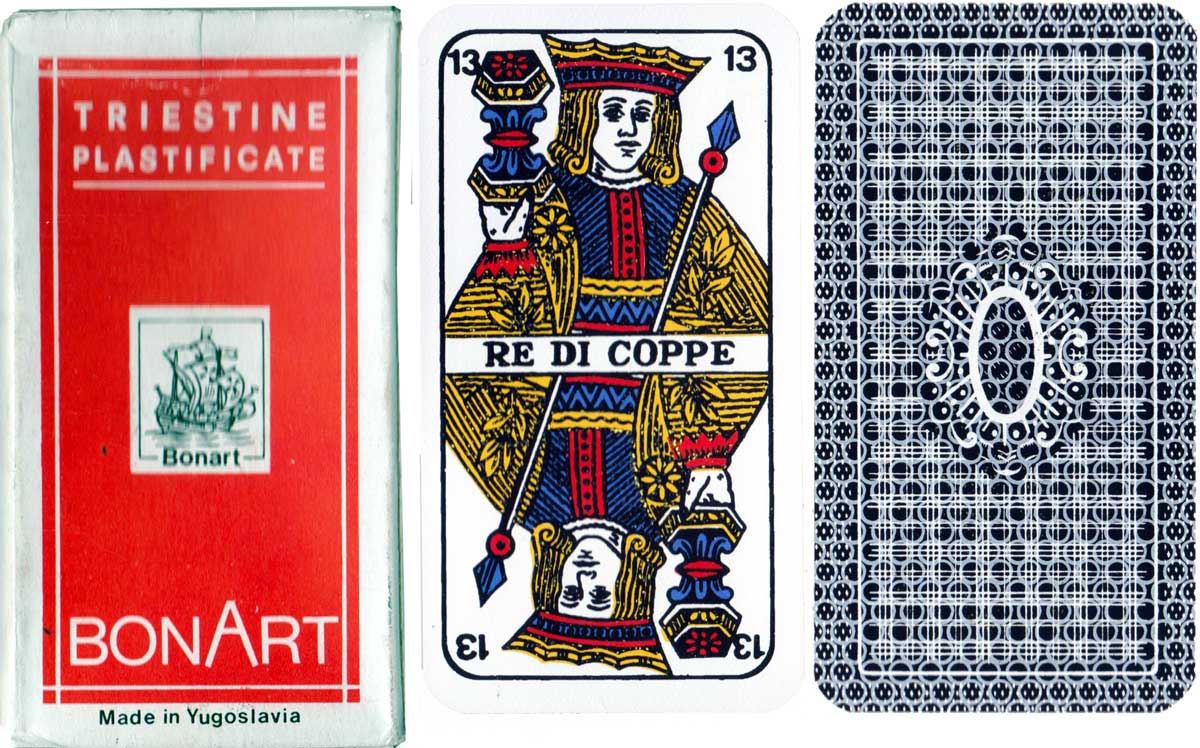Triestine Pattern
The Triestine pattern is derived from the Venetian (Trevisane) pattern but with its own characteristics.

The Triestine pattern is derived from the Venetian (Trevisane) pattern but with its own characteristics, designed for Italian speakers in Imperial territories. It is always double-ended, narrow format with 40 or 52 cards. The court cards are all labelled at the centre in Italian, and the aces each have mottoes which can vary in different locations. See the Box►




Above: Triestine pattern by Modiano, 1970s, after the abolition of playing card tax which would have appeared on the ace of coins. Images courtesy Rex Pitts.
During the Yugoslavia period the Triestine pattern was preferred on the coast. It was also manufactured in Vienna or Budapest for Adriatic provinces.

Above: Triestine pattern made in former Yugoslavia by BonArt. Image courtesy Rex Pitts.

By Rex Pitts (1940-2021)
Member since January 30, 2009
Rex's main interest was in card games, because, he said, they were cheap and easy to get hold of in his early days of collecting. He is well known for his extensive knowledge of Pepys games and his book is on the bookshelves of many.
His other interest was non-standard playing cards. He also had collections of sheet music, music CDs, models of London buses, London Transport timetables and maps and other objects that intrigued him.
Rex had a chequered career at school. He was expelled twice, on one occasion for smoking! Despite this he trained as a radio engineer and worked for the BBC in the World Service.
Later he moved into sales and worked for a firm that made all kinds of packaging, a job he enjoyed until his retirement. He became an expert on boxes and would always investigate those that held his cards. He could always recognize a box made for Pepys, which were the same as those of Alf Cooke’s Universal Playing Card Company, who printed the card games. This interest changed into an ability to make and mend boxes, which he did with great dexterity. He loved this kind of handicraft work.
His dexterity of hand and eye soon led to his making card games of his own design. He spent hours and hours carefully cutting them out and colouring them by hand.
Related Articles

Carte di Natale
Designed by Pier Canosa as a Christmas pack for the Cortina Art Gallery in Milan.

Lyon pattern made in Italy by Pietro de Santi
The Lyon pattern was initially developed in France during the 16th century. As Lyon was a trading hu...

Laurenzo Propagine
Spanish-suited cards made in Italy by Laurenzo Propagine.

Il Tarocco Mitologico
Fully pictorial Tarot designed by Amerigo Folchi with figures mainly from Greek mythology.

Neapolitan pattern by Luigi Pignalosa, Naples
Two versions of the Neapolitan pattern from the British Museum by Luigi Pignalosa, Naples, 1875 & 18...

Dylan Dog
Characters and objects from the Italian comic book series Dylan Dog, written by Tiziano Sciavi and d...

Royal Britain
Pack devised by Pietro Alligo depicting English monarchs from Alfred the Great to Elizabeth II.

Introduction to Collecting Themes
Playing cards can be broadly categorised into standard and non-standard designs, with collectors app...

Le Monde Primitif Tarot
Facsimile edition produced by Morena Poltronieri & Ernesto Fazioli of Museo Internazionale dei Taroc...

I Tarocchi del Buongustaio
A less-than-serious set of major arcana on a gourmet theme, with designs by Cosimo Musio.

Poker Lusso
Richly costumed courts on a luxury poker pack from Masenghini.

Pinocchio playing cards
Comic book drawings inspired by Carlo Collodi’s children’s classic, Pinocchio.

Le Ore playing cards
Caricatures of famous personalities from the late 1970s for the Italian magazine Le Ore.

Carte Romantiche Italiane
Scenes of life and the theatre in Milan towards the second half of the 19th century.

Lo Stampatore
‘Lo Stampatore’ linocut images created by Sergio Favret, published as a deck of cards by Editions So...

Leonardo collection
Leonardo collection playing cards with drawings from his notebooks.
Trending Articles
Popular articles from the past 28 days


